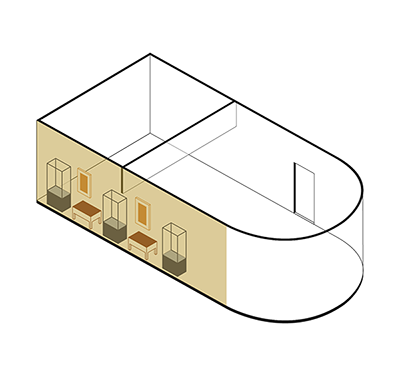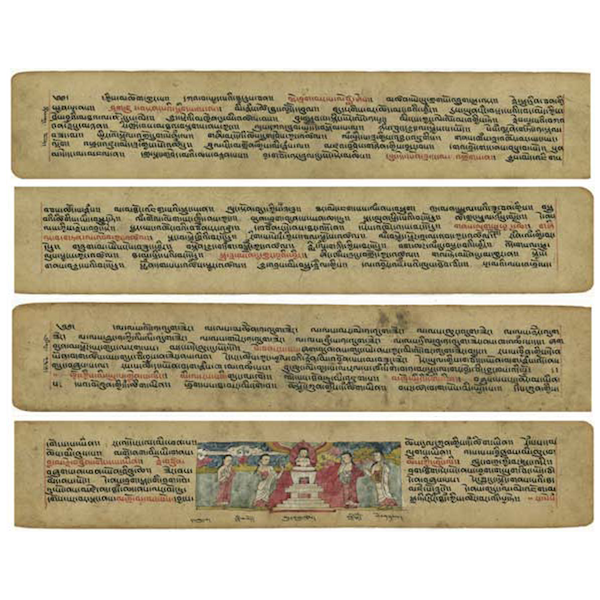Manuscript of "The Life and Songs of Mila Shepe Dorje" (DarkTreasury)
See it in the Museum

Chapel
Orientation 2
Display 4

ABM 039
Code: ABM 039
Country: Tibet
Style:
Date: 1450 - 1630
Dimensions in cm WxHxD: 11 x 44 x 9.7
Materials: Pigment on paper & carved wood cover
The hand-written manuscript in Tibetan dbu med-script (without heading line) is a combination of the life story and the collection of songs by Milarepa.
Present day researches, such as Stefan Larsson (The Birth of a Heruka, 2009) state, that the “life story” (Namthar) and the “song collection” (Gurbum) of Milarepa were composed by Tsang Nyön Heruka (1452-1507). In 1488/1491 he completed the life story of Milarepa.
A known fact to tibetology is, that Tsang Nyön Heruka did draw from already existing written sources and a rich oral tradition. One of his sources was the so-called “Black Treasury” (Dzö Nakma), complied by the 3rd Karmapa, found in the third volume of his collected writtings.
The present manuscript is a version of Milarepa’s songs and life which predates Tsang Nyön Heruka’s writtings on Milarepa. It clearly a version authored by the 3rd Karmpa, only with a different title and a very interesting colophon. The colophon reports about the early lineage, how the Milarepa legend was transmitted.
The colophon at the end of the text states: The material was gathered and written down under the supervision of Milarepa himself and he himself made amendments to the text. He himself gave the reading transmission and it was handed down from his heart-student Rechungpa via the first Karmapa all the way down to the sixth Karmapa.
It was the 3rd Karmapa, who corrected the early material of Milarepa’s songs and biographical stories and produced a text called the “Black Treasury”, the “Dzö Nakma”, which was handed down until the 6th Karmapa in a secret fashion, in the socalled “one-to-one-person-transmission”.
If we believe the colophon, then this text represents the authoritive version, that was aproved by Milarepa himself. The colophon also states, that all later versions of the Milarepa legend go back to this version.
The colophon of our text does not give any date when our version of the Black Treasury was copied. The 6th Karmapa Thongwa Dönden, who is mentioned in the colophon, lifed in the 15th century: (1416-1453). His student, the first Trungpa Rinpoche, is also mentioned in the colophon. The spelling of the Tibetan language is not archaic. One does not find the old “mid la ras pa” but rather modern “mi la ras pa”. I would carefully place the text in the 16th century and call it a copy of the socalled “Black Treasury”.
The “Black Treasury” (Dzö Nakma) is mentioned as one of the three known written sources, that Tsang Nyön Heruka used for the compilation of his edition of the collected songs and the life story of Milarepa.
The TBRC-website by Gene Smith provides three versions the “Black Treasury” by the 3rd Karmapa. The present manuscript will be very valuble for future Milarepa research.
Here follows a translation of the colophon, folio 322b-323a:
This is the history of the “Black Treasury” – the “collections of songs” of Milarepa, the venerable King – handed down through the Dharma-Lord Karmapa: “In the Water- Ox-year (1133), when the great Venerable One (Milarepa 1052-1135) was 82 years old, his students, headed by Ngen Jong Repa and Shiwa Ö, requested him again and again. Then the Venerable One spoke: ‘ ... You (studends) should go to the places, where I formerly practiced.
Gather piece-work of (stories and songs), written down on barks of trees and on Tala- leaves. Since most (of the stories and songs) are present in the mind of Tseringma (the Sister of Longevity) you can clarify what is not clear to Ngen Jong Repa and to you (students).’
Then his great sons gathered (episodes and songs) from everywhere and requested Tshering ma during a Gana-Chakra-ceremony. They also gathered what the Repas (the cotton glad ones) knew by heart and put (the material) in order. The Venerable One himself provided his amendments and (all) was arranged in the style of a life story (rnam thar). When (Milarepa) was giving the reading-transmission, the Venerable One said: ‘Keep this well! After two years I will die. I will do prayers, that this life-story I have told, will be an auspicious object of devotion for everyone.’ Thus (he uttered verses of) auspiciousness together with prayers.
Rechungpa brought the book to Loro. The Dharma-Lord Düsum Khyenpa went to Loro and received the reading-transmission from Rechungpa. He copied the book and brought it to Tshurphu. The great Drogön Repa received (the reading-transmission) from him (Düsum Khyenpa). Pom Ragpa received it from him (Drogön Repa). Karma Pakshi received it from him (Som Rakpa). He (Karma Pakshi) brought the book to Kongpo and placed it insite the “Black Treasure” of Tselagang. Karma Pakshi’s (studend named) Nyenre Gendün Bum received (the reading-transmission from Karma Pakshi). He (Nyenre Gendün Bum) gave it to Rangjung Dorje, who gave it to Gyalwa Yungtönpa, who gave it to the 4th Karmapa Rölpe Dorje, who gave it to Kachö Wangpo, who gave it to Deshin Shekpa, who gave it to Kazhi Rigpe Raltri and who gave it to Thongwa Dönden. Drung Rinchen Dorje received (the reading-transmission) from him (Thongwa Dönden). Until that time it was a tradition, that was passed on “from one master to one student only”.
Nangso Kunga Gyaltshen received (the reading-transmission) directly from Thongwa Dönden and brought the book back from Kongpo. That is how the historical story goes up to this point.
It seems that many devotees made this book the “main-source” and produced many copies (of the book).
(End of the book).
Present day researches, such as Stefan Larsson (The Birth of a Heruka, 2009) state, that the “life story” (Namthar) and the “song collection” (Gurbum) of Milarepa were composed by Tsang Nyön Heruka (1452-1507). In 1488/1491 he completed the life story of Milarepa.
A known fact to tibetology is, that Tsang Nyön Heruka did draw from already existing written sources and a rich oral tradition. One of his sources was the so-called “Black Treasury” (Dzö Nakma), complied by the 3rd Karmapa, found in the third volume of his collected writtings.
The present manuscript is a version of Milarepa’s songs and life which predates Tsang Nyön Heruka’s writtings on Milarepa. It clearly a version authored by the 3rd Karmpa, only with a different title and a very interesting colophon. The colophon reports about the early lineage, how the Milarepa legend was transmitted.
The colophon at the end of the text states: The material was gathered and written down under the supervision of Milarepa himself and he himself made amendments to the text. He himself gave the reading transmission and it was handed down from his heart-student Rechungpa via the first Karmapa all the way down to the sixth Karmapa.
It was the 3rd Karmapa, who corrected the early material of Milarepa’s songs and biographical stories and produced a text called the “Black Treasury”, the “Dzö Nakma”, which was handed down until the 6th Karmapa in a secret fashion, in the socalled “one-to-one-person-transmission”.
If we believe the colophon, then this text represents the authoritive version, that was aproved by Milarepa himself. The colophon also states, that all later versions of the Milarepa legend go back to this version.
The colophon of our text does not give any date when our version of the Black Treasury was copied. The 6th Karmapa Thongwa Dönden, who is mentioned in the colophon, lifed in the 15th century: (1416-1453). His student, the first Trungpa Rinpoche, is also mentioned in the colophon. The spelling of the Tibetan language is not archaic. One does not find the old “mid la ras pa” but rather modern “mi la ras pa”. I would carefully place the text in the 16th century and call it a copy of the socalled “Black Treasury”.
The “Black Treasury” (Dzö Nakma) is mentioned as one of the three known written sources, that Tsang Nyön Heruka used for the compilation of his edition of the collected songs and the life story of Milarepa.
The TBRC-website by Gene Smith provides three versions the “Black Treasury” by the 3rd Karmapa. The present manuscript will be very valuble for future Milarepa research.
Here follows a translation of the colophon, folio 322b-323a:
This is the history of the “Black Treasury” – the “collections of songs” of Milarepa, the venerable King – handed down through the Dharma-Lord Karmapa: “In the Water- Ox-year (1133), when the great Venerable One (Milarepa 1052-1135) was 82 years old, his students, headed by Ngen Jong Repa and Shiwa Ö, requested him again and again. Then the Venerable One spoke: ‘ ... You (studends) should go to the places, where I formerly practiced.
Gather piece-work of (stories and songs), written down on barks of trees and on Tala- leaves. Since most (of the stories and songs) are present in the mind of Tseringma (the Sister of Longevity) you can clarify what is not clear to Ngen Jong Repa and to you (students).’
Then his great sons gathered (episodes and songs) from everywhere and requested Tshering ma during a Gana-Chakra-ceremony. They also gathered what the Repas (the cotton glad ones) knew by heart and put (the material) in order. The Venerable One himself provided his amendments and (all) was arranged in the style of a life story (rnam thar). When (Milarepa) was giving the reading-transmission, the Venerable One said: ‘Keep this well! After two years I will die. I will do prayers, that this life-story I have told, will be an auspicious object of devotion for everyone.’ Thus (he uttered verses of) auspiciousness together with prayers.
Rechungpa brought the book to Loro. The Dharma-Lord Düsum Khyenpa went to Loro and received the reading-transmission from Rechungpa. He copied the book and brought it to Tshurphu. The great Drogön Repa received (the reading-transmission) from him (Düsum Khyenpa). Pom Ragpa received it from him (Drogön Repa). Karma Pakshi received it from him (Som Rakpa). He (Karma Pakshi) brought the book to Kongpo and placed it insite the “Black Treasure” of Tselagang. Karma Pakshi’s (studend named) Nyenre Gendün Bum received (the reading-transmission from Karma Pakshi). He (Nyenre Gendün Bum) gave it to Rangjung Dorje, who gave it to Gyalwa Yungtönpa, who gave it to the 4th Karmapa Rölpe Dorje, who gave it to Kachö Wangpo, who gave it to Deshin Shekpa, who gave it to Kazhi Rigpe Raltri and who gave it to Thongwa Dönden. Drung Rinchen Dorje received (the reading-transmission) from him (Thongwa Dönden). Until that time it was a tradition, that was passed on “from one master to one student only”.
Nangso Kunga Gyaltshen received (the reading-transmission) directly from Thongwa Dönden and brought the book back from Kongpo. That is how the historical story goes up to this point.
It seems that many devotees made this book the “main-source” and produced many copies (of the book).
(End of the book).
Bock, Etienne; Falcombello, Jean-Marc; Jenny Magali, 2022. Trésors du Tibet. Sur les pas de Milarépa.. Paris: Flammarion. P. 260 détails: pp. 62, 65, 66, 124, 127, 128, 148, 151, 152, 178, 198, 201, 202, 224, 227, 230, 252, 278, 281, 282

